Lake Pontchartrain is a large lake with an even more prominent place in the hearts of many who call New Orleans home. It is also laced with heavy memories of August 29th, 2005, when Hurricane Katrina battered the city and caused heavy flooding around the failed levees and Lake Pontchartrain. The neighborhoods on the south side of Lake Pontchartrain were severely flooded, and many were utterly destroyed. What was even worse was that the water had nowhere to drain. The standing water remained, which caused significantly more problems than the hurricane itself.
It’s hard to believe that the fateful and horrible few weeks of miseries kicked off 18 years ago on August 29th. Many businesses and houses have been rebuilt, and the city looks to be holding up well nearly 20 years later. If you cruise through some of the neighborhoods in Orleans Parrish, you can still see many homes brandished with an “X,” showing how many people were inside and if any were alive, the date, and sometimes the unit that swept the house for humans. Thankfully, they have not had another situation like that since, and the city is now much more equipped to handle weather emergencies and flooding.
A Little History
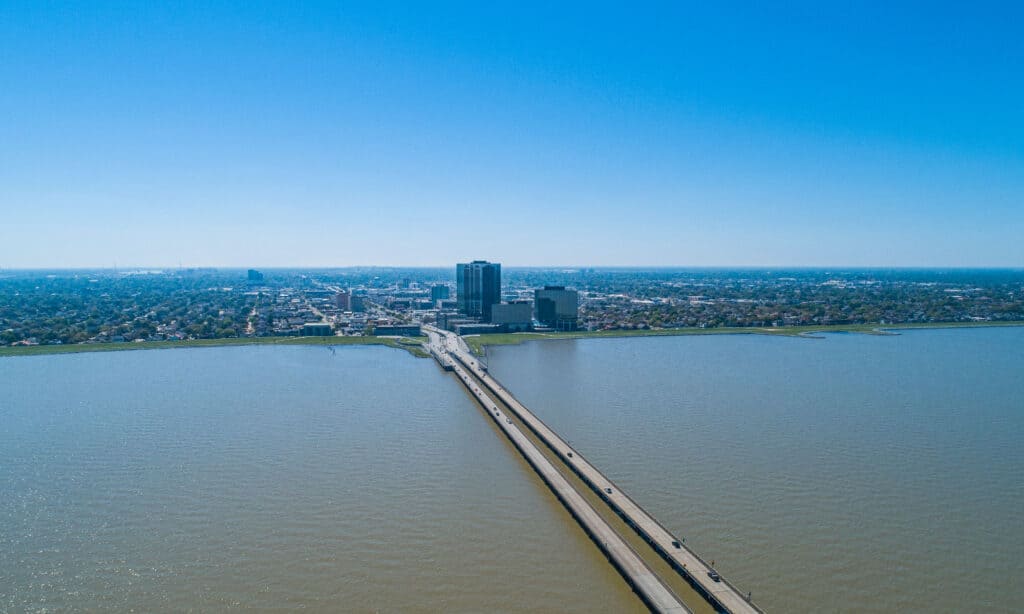
The Lake Pontchartrain Causeway of Louisiana, 23.9 miles long, is the longest bridge in the United States.
©Mark Runde/Shutterstock.com
The Lake Pontchartrain Causeway of Louisiana, 23.9 miles long, is the longest bridge in the United States.
Around 5,000 years ago, the North American glacier began to melt, and as it did so, it caused the Mississippi River to get to such depths that it began to shift to the east. By doing so, it began to deposit sediment into the Gulf of Mexico, which created a vast delta that would later in history become Orleans, St. Bernard, and Plaquemines Parishes. Over 2,000 years, the delta continued to grow, which carved away part of the land to make way for what would later become Lake Pontchartrain. The Native American Choctaw tribe called the wide body of brackish water Okwa-ta, meaning “wide water.” The tribes that called the shores of the lake home were the Bayougoula, Mougoulacha, Chitimacha, Oumas, Tangipahoa, Colapissa, and Quinipissalive.
In 1699, Pierre La Moyne, Sieur d’Iberville, who was a French settler, ended the peace the Native Americans had on the edge of the lake when he decided to rename the lake Lake Pontchartrain. The name was to pay homage to the current French Minister of the Marine at the time, Comte de Pontchartrain. Since that day, the lake has always been called Lake Pontchartrain.
What’s in the Lake?
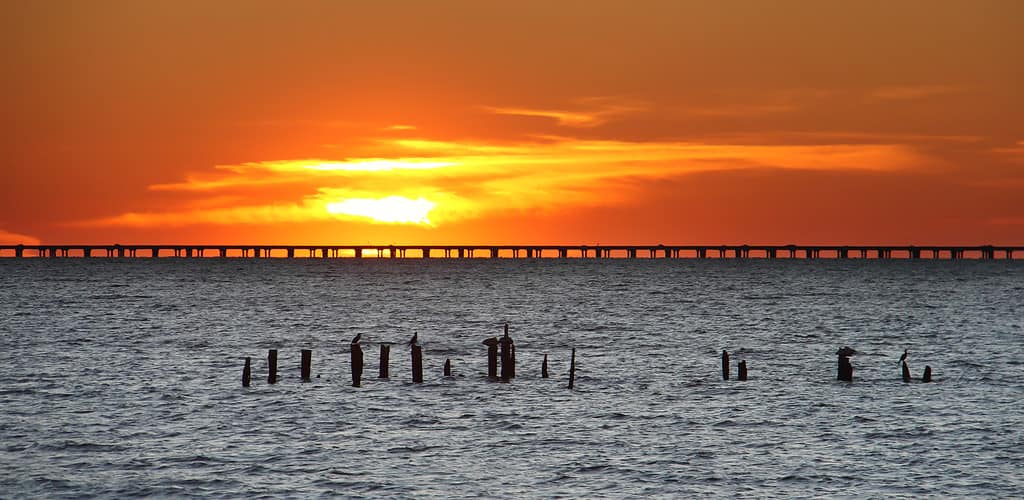
Though the lake can appear calm at times due to its shallow depth, it can change at a moment’s notice and produce strong currents and waves.
©iStock.com/XKarDoc
Lake Pontchartrain is an estuary that covers 630 square miles. Many types of shore birds, fish, sharks, and other wildlife call this shallow lake home. Many of the animals in the estuary are endangered, some critically so. A number of the birds that call this area home only reside here, and problems within the estuary would certainly mean death for them.
1. American Alligator (Alligator mississippiensis)
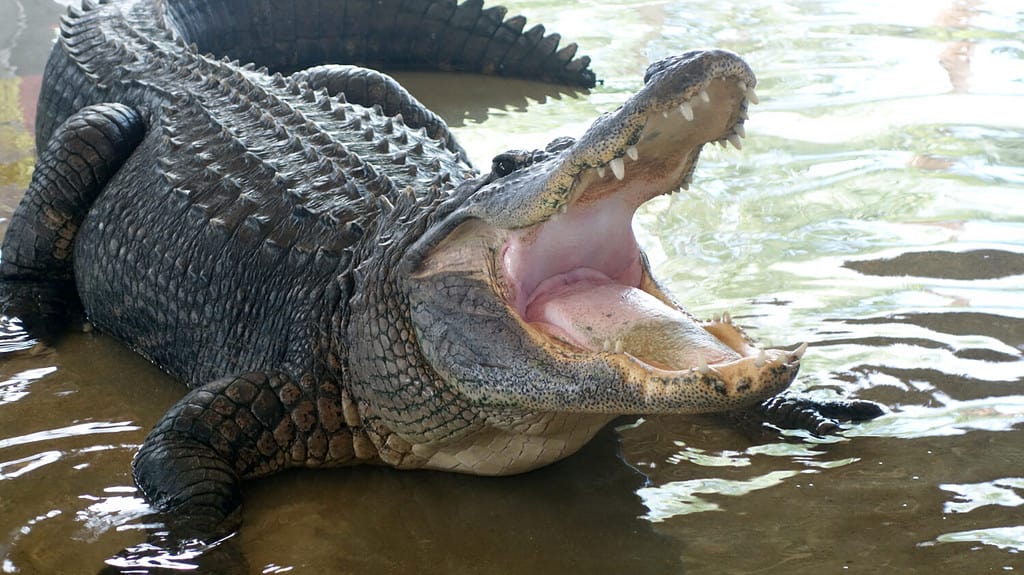
Alligators live in murky water where they can lie on the muddy bottom.
©Ernie Hounshell/Shutterstock.com
Appearance: Large greyish-green cold-blooded prehistoric lizards with large teeth and long curved claws.
Size: Up to 14 feet long and the possibility of weighing up to 1000 pounds
Dangers: It is not all that likely that you will come face to face with a colossal alligator while floating around in a kayak, but it is possible. Alligators like to remain near the shore, and Lake Pontchartrain is a very popular place to take boats, jet skis, and other noisy contraptions that alligators aren’t huge fans of. Since it is Louisiana and all things are possible, avoid swimming near the shore if it is not a populated area.
2. Bull Shark (Carcharhinus leucas)
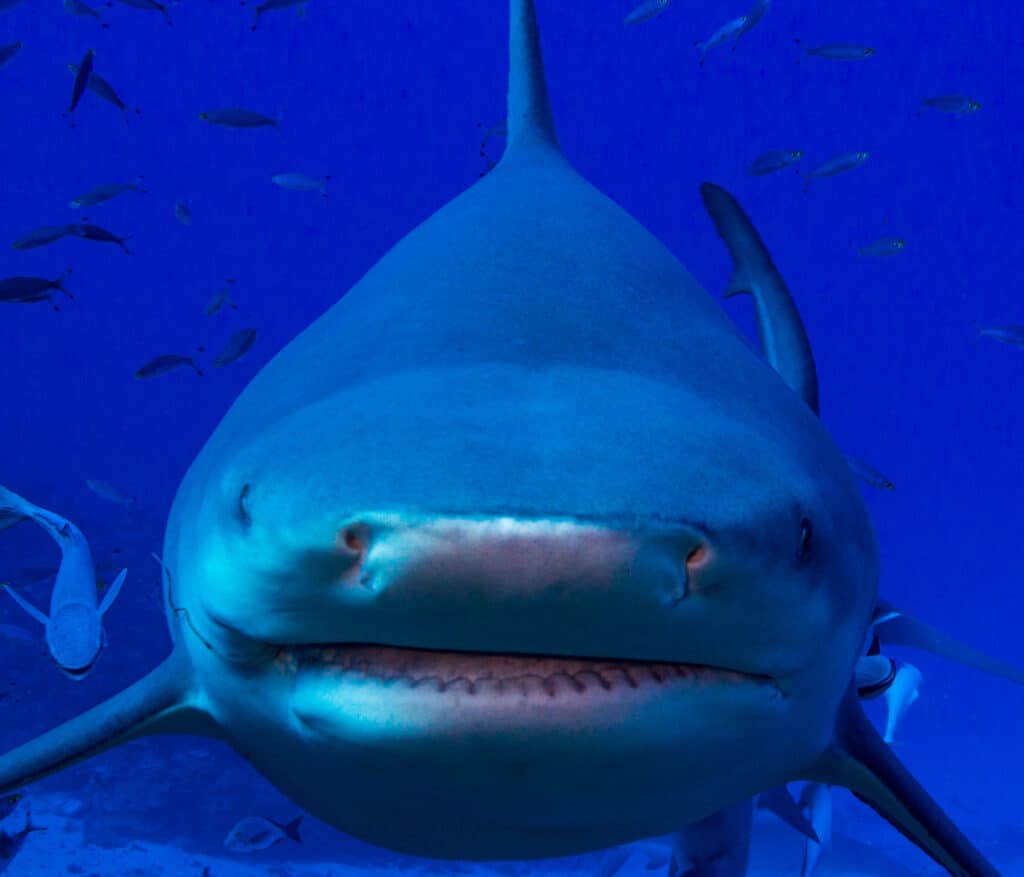
Bull sharks are the most aggressive shark species because of their high testosterone.
©Michael Gomes/Shutterstock.com
Appearance: Greyish on top with a lighter bottom.
Size: 7 – 12 feet long and 200 – 500 pounds
Dangers: There hasn’t been a fatality in Lake Pontchartrain from an attack since 1914. Bull sharks treat the lake as an estuary, and any seen are likely juvenile sharks. Since bull sharks are comfortable in brackish water, they can live in the lake as long as they want. Numerous kayakers have seen bull sharks swimming underneath the causeway near the pillars. It is unlikely that you would be attacked, but it is not unheard of.
3. Blacktip Shark (Carcharhinus limbatus)

Blacktip sharks are social and swim and hunt in groups.
©Longjourneys/Shutterstock.com
Appearance: Grey upper with white underside and black-tipped fins.
Size: 4.9 – 8 feet long and 50 – 150 pounds
Dangers: These sharks are not aggressive towards humans unless they are in a feeding frenzy. If you are fishing, stay in your boat. Do not hang bloodied fish near you and fish while in the water. They are voracious hunters and can be very dangerous in a feeding frenzy. Kayakers have reported seeing these shark-feeding frenzies near piers overlooking the lake after fishers have dumped their bait in the water.
4. Alligator Gar (Atractosteus spatula)
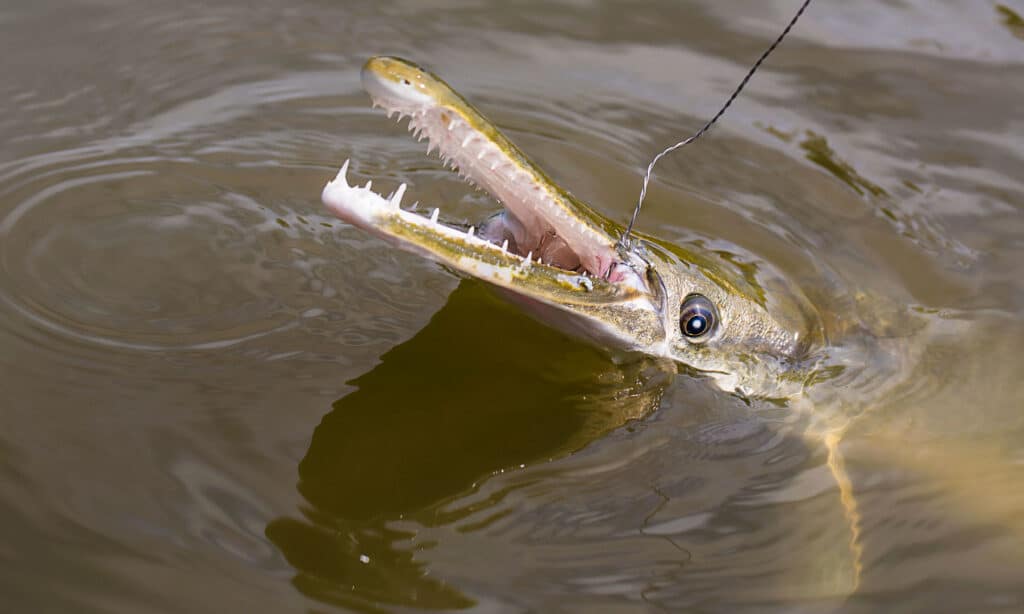
Alligator gars have no interest in hunting humans but can grow to be very large.
©Jennifer White Maxwell/Shutterstock.com
Appearance: Olive brown with glistening scales and a lighter-colored underside. They have a long, flat snout and fins that are set at the rear of the body.
Size: 6 – 10 feet long and 100 – 350 pounds
Dangers: There haven’t been any recorded attacks. Though it is unlikely, they could confuse fingers or toes in the water for fish. They can become enormous and can seem very intimidating, but they do not want anything to do with humans. They can sometimes be seen in the lake as they swim along the surface in the late afternoon and evening before sunset.
5. Alligator Snapping Turtle (Macrochelys temminckii)

Alligator snapping turtle’s bite force is 158 newtons, which is more than is needed to snap through bone.
©iStock.com/Sista Vongjintanaruks
Appearance: Large shell, large head with a hooked beak, and very long neck. They are a muddy greenish color with points on their shell. They have unique, long, skinny tongues with what looks like a red worm at the end to attract prey.
Size: Up to 31 inches long and 50 – 220 pounds
Dangers: These turtles are the largest in the United States and among the largest in the world. They are dangerous because you might never know you are around one until it is too late. The turtles tend to be relatively aggressive and wouldn’t take too kindly to being stepped on. They are more common in strictly freshwater but are definitely in the lake, along with their much smaller but equally ill-tempered cousins, the common snapping turtle.
6. Gulf Sturgeon (Acipenser oxyrinchus desotoi)

Gulf
Sturgeon
are amazing living fossils and are very rarely seen in the lake, but they are there along with many other Gulf creatures you might not ever guess could be in a lake.
©Chase D’animulls/Shutterstock.com
Appearance: Black and olive green to silvery blue on top and have pearly white undersides.
Size: 7 – 14 feet and over 300 pounds, with the females being larger than the males
Dangers: Gulf sturgeons are not generally considered dangerous, though they have injured plenty of people with their massive size while leaping out of the water. They have jumped into boaters, anglers, and swimmers and can break bones and cause significant injuries while leaping. The Gulf sturgeon is an endangered species, and it is illegal to catch one.
7. Blue Catfish (Ictalurus furcatus)

Appearance: Four pairs of black barbel whiskers on their face reminiscent of a cat. Their mouth is as wide as their body for sucking up lake and riverbed algae, plankton, clams, worms, small fish, and aquatic insects. They have a forked tail and are silvery blue on the top and white on their underside. They do not have scales.
Size: 2 – 5 feet long and 70 – 140 pounds
Dangers: Catfish are bottom dwellers who do not want anything to do with humans and will avoid them if possible. If a catfish is stepped on or caught, they will defend themselves using their dorsal and pectoral fin serrated spinal barbs. The barbs are bad enough, but they come equipped with a gland in the barbs that releases toxins that cause severe burning pain to help the predator or fisher remember not to mess with them again. As if this all weren’t bad enough, the toxins will cause severe skin necrosis. This giant fish is many times worse than a brown recluse spider bite.
8. Oil and Grease

Oil and grease disrupt every stage and type of life in and around a lake.
©Denise Hasse/iStock via Getty Images
Appearance: Oil and grease will appear to have a shimmery rainbow look in some places, but oil has a look similar to mud on top of the water near the shoreline.
Cause: Water running off and draining into the lake. The runoff contains oil and grease from the pavement, combined with gasoline from spills, vehicles, boats, and gas stations. Grease can come from axles, the food industry, mechanical companies, and so much more.
Dangers: By now, everyone on the planet should be aware of what an oil spill in the ocean, specifically the Gulf of Mexico, looks like and the detrimental effects it has on wildlife, drinking water, plant growth, fish, and everything it comes in contact with. It kills everything it touches, to put it mildly. It is very difficult to eradicate from water, sediment on lake shores, and the wildlife that call it home. Petroleum pollutants cause deformities in fish and cancer in most living beings.
9. Cyanobacteria
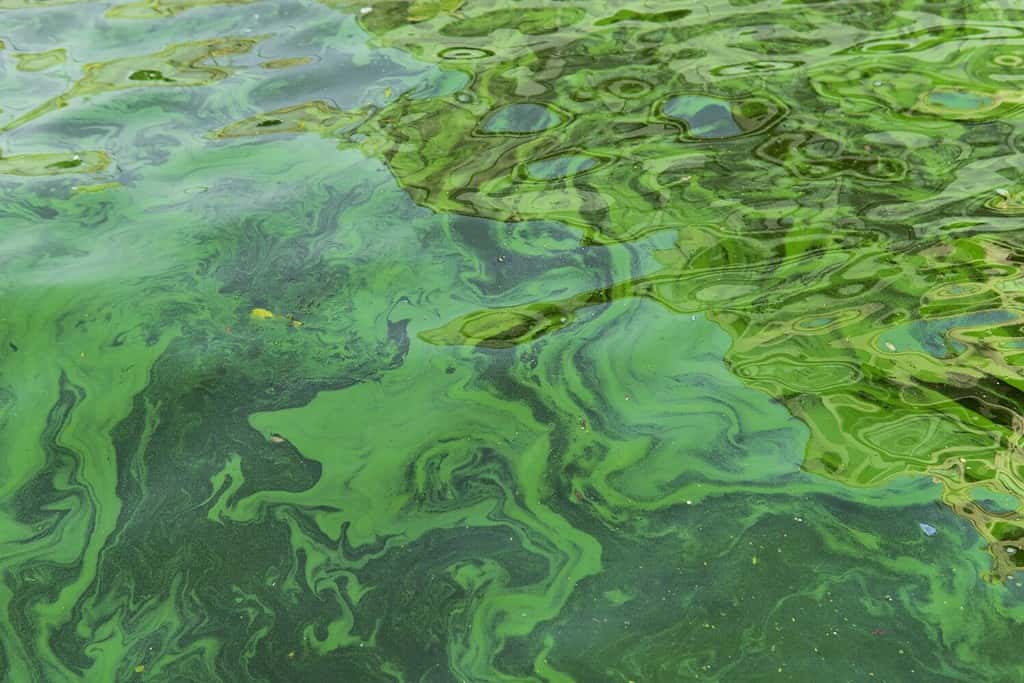
Cyanobacteria can make food using sunlight, so long as they have wet soil or water. Cyanobacteria’s common name is blue-green algae.
©Aleksandrkozak/Shutterstock.com
Appearance: Bluish green algae that forms on the surface of lakes, most commonly near shorelines and calm, shallow areas.
Cause: Septic overflows, fertilizer runoffs, cattle farms, high water temperature, high levels of nitrogen and phosphorus, increased carbon dioxide in the atmosphere,
Dangers: Cyanobacteria can cause mild effects like skin irritation, stomach cramps, vomiting, nausea, diarrhea, fever, sore throat, headache, muscle, liver damage and joint pain, and blisters to more serious long-term effects like neurodegenerative diseases like Alzheimer’s disease and ALS. It is also hazardous for animals.
10. Sewage
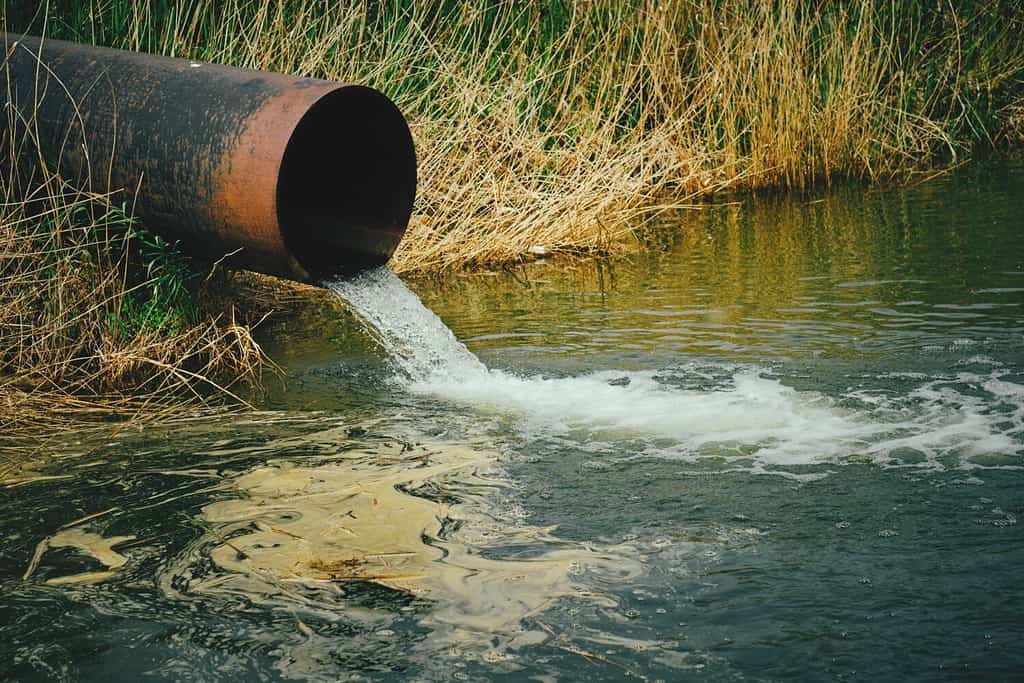
If a large amount of sewage enters a body of water, it can kill everything in it.
©Dmitriy Prayzel/Shutterstock.com
Cause: Everything put down a drain goes to the sewer. When excessive rain, trash, automotive chemicals, fertilizer, and pesticides are already down in the sewer from the street, they can overflow and end up in our waterways. Something like a deteriorated sewage pipe can cause grave consequences.
Dangers: It is estimated that 3.5 million Americans get sick every year from swimming, boating, swallowing, or touching contaminated water. Many diseases of the yesteryears can come alive with contaminated water, like E. coli, salmonella, hepatitis, dysentery, and cryptosporidium. It’s possible to get milder sicknesses like ear and eye infections and diarrhea from eating products like seafood that have been in contaminated waters. Either way, it is not something you want to catch.
11. Pesticide
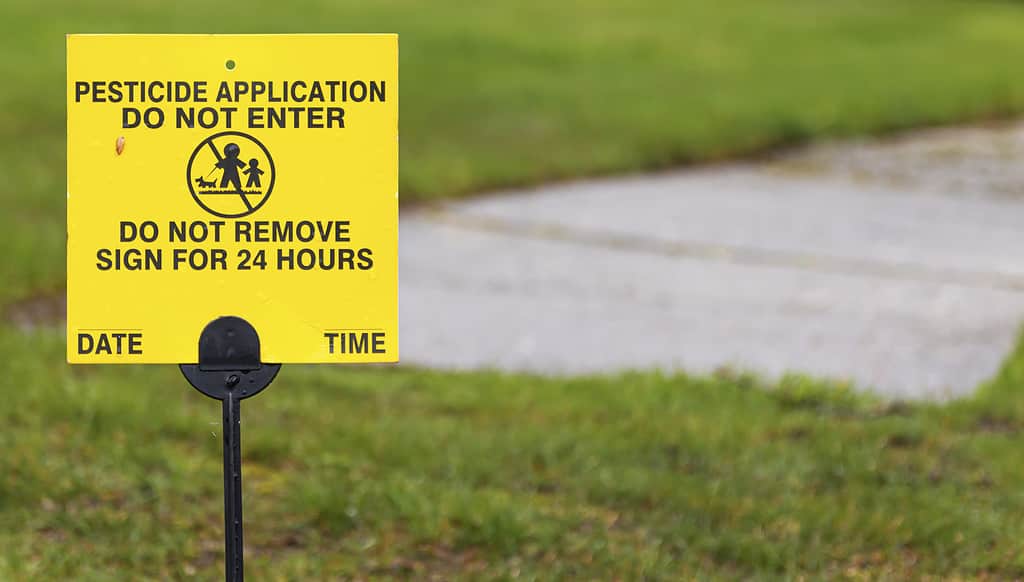
Pesticides poison the earth and its inhabitants in more ways than one.
©WoodysPhotos/iStock via Getty Images
Cause: Pesticides seep into the ground along with rainwater, poisoning the soil. It can also run off into the sewer, which will inevitably end up overflowing with heavy rainfall into bodies of water nearby. Some of the pesticides can stick to the sediment at the bottom of the lake and continue to poison it for a long time. On a large scale, pesticides from agricultural areas can dump large loads of insecticide into waterways over and over.
Dangers: The harmful chemicals found in pesticides are hazardous to animals and humans. It is also one of the leading killers of bees and other pollinators. They can cause severe mutations in wildlife and fish. Not all pesticides will harm humans, but it is not something you want to contaminate your body with. Long-term effects of exposure to pesticides include various cancers and other diseases.
12. Lawn Chemicals
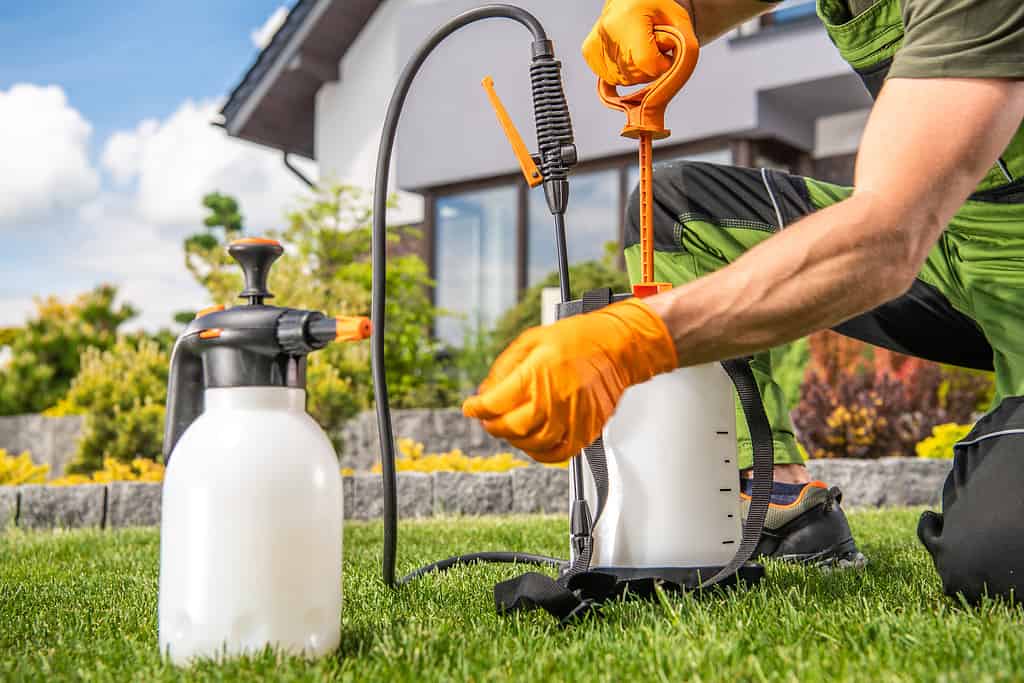
Lawn chemicals are extremely dangerous for every living being and should not be used.
©welcomia/iStock via Getty Images
Causes: Whenever a lawn is treated with chemicals, those same chemicals end up in the sewer, in your drinking water, in local bodies of water, in agricultural animals like cows who create milk that some of us eat, and so much more. There aren’t any good reasons to use lawn chemicals since they kill way more than weeds. They also kill pollinators, insects, and spiders, contaminating the entire food chain. They also end up in our waterways through runoffs and rains.
Dangers: There are many dangers to swimming in contaminated waters. If the level of contamination is high enough, it can cause blindness, cancers, diseases, and a host of other terrible side effects. Even if the levels are not high, would you put your children in a bathtub with a scoop of Roundup?
13. Dangerous Water
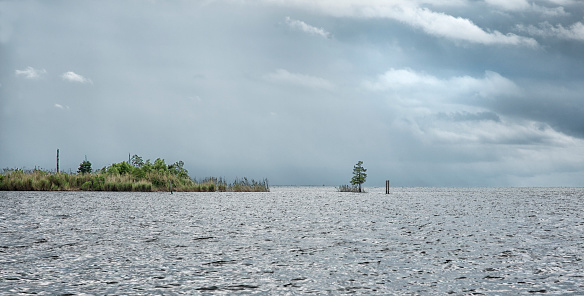
A tiny island with a single cypress tree holds on despite high water and a raging storm.
©Judy Darby/iStock via Getty Images
Cause: Thunderstorms pop up just about every afternoon in New Orleans during the summer. The storms are generally quick but pack a dangerous punch, especially if you’re in a small vessel on the lake. Since the average depth of Lake Pontchartrain is 12 feet, it doesn’t take much to create epic waves and a nasty current very quickly. It is essential to pay attention to the clouds. As soon as you see them moving in, it’s time to head to the shore quickly if you are in a canoe, kayak, paddleboard, or similar.
Dangers: Once the lake has a bit of wind across it from impending storms, you will want to get out of there fast. The wind creates massive waves that can knock a person out of a kayak or small vessel. Even with a life jacket on, it is perilous. A lot of the shoreline still has broken concrete and rebar sticking out, so climbing up the high bank isn’t safe for many reasons. Always take a friend if you plan to go out on the lake. Also, always bring a brightly colored (not blue, grey, or black) life jacket, a cell phone in a water-resistant bag, and know how to swim well. Speaking as a former kayaking New Orleanian, it’s better to be safe than sorry. The wind and storms are by far the most dangerous part of the lake.
The Answer

Lake Pontchartrain is serene and beautiful. Kayaking is a one-of-a-kind experience, but caution needs to come first.
©Entropyd/iStock via Getty Images
This article could be considerably longer regarding everything you might encounter in Lake Ponchartrain. Since it is connected to the Gulf of Mexico, you might see many sea creatures you wouldn’t expect, from puffer fish to dolphins. But is it safe to swim in? That is up to the person asking. There are many more risks to swimming in the ocean, yet people do it in flocks every summer. Do not drink the lake water.
Something to consider is that a man once began swimming at 9 p.m. and made it across the lake without issue or injury. Also, know that with warming temperatures and rising sea levels, the chances of a large quantity of sea life that might not have entered the estuary is now very possible. Most sharks cannot tolerate brackish water for long, though many other creatures that once only lived in the hot ocean temperatures closer to the equator are now moving north, and Louisiana would be one of the first stops.
FAQ
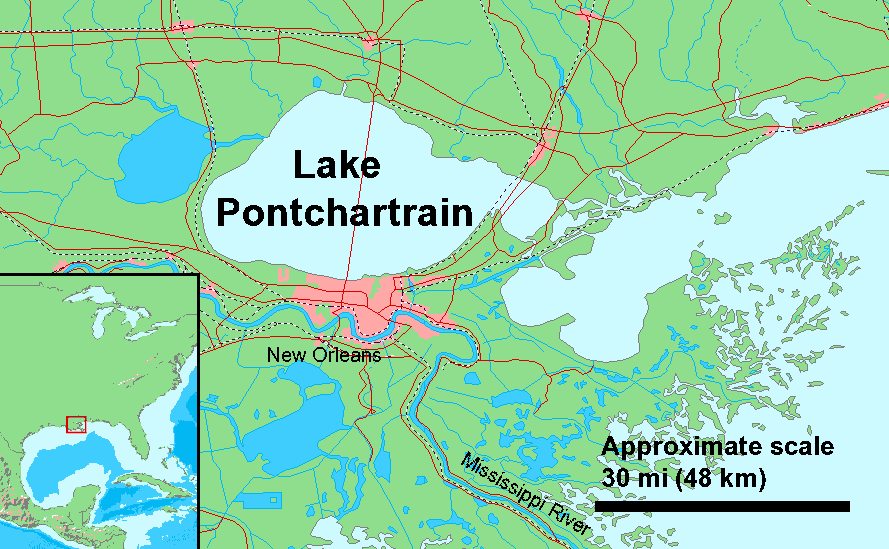
©Derived from Demi Public Domain Map Server, Public Domain data sources used / Duk (User) / CC BY-SA 3.0 – Original / License
Q: Why couldn’t you swim in Lake Pontchartrain years ago?
A: Lake Pontchartrain used to be heavily polluted from shell-dredging and chemical and sewage runoff. After decades of fighting to clean the lake, it is finally at its cleanest in a very long time. The clam shells are used to create roadways throughout the state.
Q: Has anyone swam across Lake Pontchartrain?
A: Yes, Matthew Moseley swam the 25 miles across the lake. It took him 15 hours of nonstop swimming. People awaiting his arrival had to chase away a small alligator from the area where he was supposed to come out of the lake.
Q: How deep is Lake Pontchartrain?
A: At the deepest spots, it is 65 feet deep. That depth makes it the second-deepest lake in Louisiana. On average, the lake is 12 – 14 feet deep.
Q: What is the longest bridge over water in the world?
A: The Causeway Bridge over Lake Pontchartrain is 23.79 miles across and is the longest continuous bridge over water globally.
Q: Did Lake Pontchartrain flood during Hurricane Katrina?
A: Yes, the entire south shore of Lake Pontchartrain in New Orleans, Kenner, and Metairie flooded significantly during the hurricane. Lots of homes were destroyed, and people were stranded in their attic and on rooftops.
Q: Will New Orleans exist in 2050?
A: The Crescent City has been sinking for years due to rising sea levels. Climate change is speeding up, so the probability that New Orleans will be there in a few decades is not looking good. By that time, the city could be underwater.
Thank you for reading! Have some feedback for us? Contact the AZ Animals editorial team.








